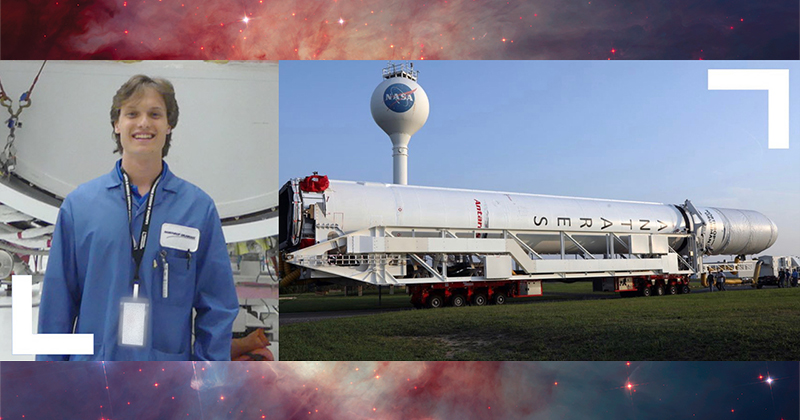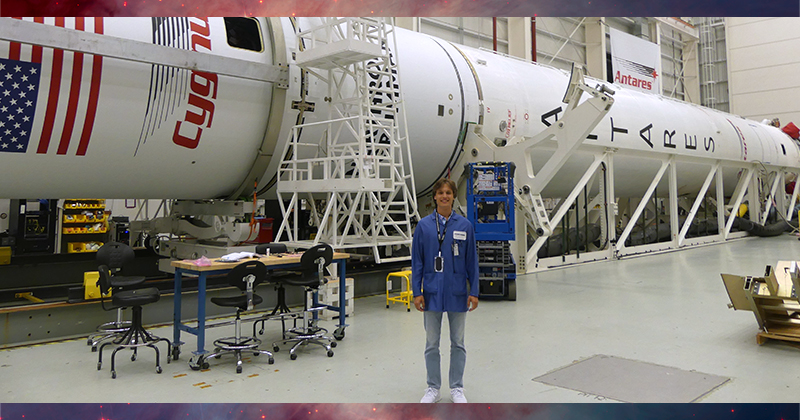


Mission accomplished
Courtesy of Cameron Emmett/NASA October 05, 2023
Mechanical engineering student Cameron Emmett supported successful rocket launch to the International Space Station
As the countdown reached T-minus 30 seconds, senior Cameron Emmett waited nervously for Northrop Grumman’s 19th resupply mission to finally take off. “That last 30 seconds feels like an hour — a lot of anticipation and nervousness,” he reflected. “Then, when the rocket finally took off, it was incredibly rewarding.”
Emmett, a mechanical engineering major at the University of Delaware, was part of the team that helped the NG-19 mission take off successfully on Aug. 1. While completing a summer internship with Northrop Grumman at NASA’s Wallops Flight Facility, Emmett helped ready the Antares 230+ rocket for its mission to launch the Cygnus spacecraft and resupply the International Space Station (ISS).
Aerospace engineer-in-training
Emmett, who is from Middletown, Delaware, said that having a teacher for a mother and a carpenter for a father fostered his interests in math, science and working with his hands.
“When I learned about what engineering was — designing and solving a problem — that inspired me to become an engineer,” he said. Emmett also has long been interested in all things outer space, an interest he shares with his grandmother and a grandfather who lived near the NASA launch site at Wallops Island.
After applying for an internship with Northrop Grumman at its Elkton location last fall, Emmett received an interview for a different position as a member of the pneumatics team working at the Wallops Island facility. He was eager for the opportunity to both work on something space-related while applying the skills he’d gained while studying mechanical engineering (with an aerospace engineering concentration) at UD.
“The goal of the internship was to get the rocket launched,” Emmett said. “A few weeks after I got to Wallops Island, Northrop Grumman had gotten approval for the August launch. It was all hands on deck getting the last things ready.”
Working under the mentorship of Deputy Pneumatics Lead Emma-Leigh Cameron, Emmett spent his summer working on pneumatics integration and testing. Pneumatics is the branch of engineering that uses high-pressure gasses; for the Antares rocket, pneumatic systems are used to control valves and switches and aid in propulsion.
While working alongside Wallops Island’s 55 full-time staff this summer, Emmett spent much of his time in the facility’s High Bay, an indoor space large enough to house the entire rocket when it’s fully assembled.
“A lot of my day was spent doing pneumatic testing, so proof testing parts to make sure that they won't fail at the pressures that we need them to work at,” Emmett said about a typical day during his internship. “Then, we would also put them on to the rocket and monitor the pressures of the systems after they were assembled.”
Emmett said that one major lesson he learned from the internship was in seeing how different teams collaborated effectively to ensure that everything worked smoothly and safely.

“One of my biggest takeaways was to see all the coordination between teams. We weren't just working with people on our site, but also across the country,” he said. “Learning how to get around any challenges by communicating clearly was probably the biggest thing I learned.”
He also had the opportunity to shadow staff in other teams, visited the site’s mission control facility, and even had a stint on the night shift at the launch pad as everyone at Wallops Island worked tirelessly to get the rocket ready for lift-off.
3, 2, 1…
As the day of the launch finally arrived, Emmett was joined at Wallops Island by family and friends. They were able to get a spot at one of the site’s best viewing points, a decommissioned ferry port just outside of the safe viewing radius known as the “hazclear.”
Along with the excitement of getting to see the rocket take off on launch day, and learning about the level of coordination that it takes to successfully launch a rocket, Emmett also enjoyed the opportunity to learn more about the field of pneumatics. In his spare time, he said he would ask lots of questions and study engineering diagrams, comparing how they looked on paper during the design process to how they came together in the High Bay.
“Another thing that surprised me is how well they’ve planned for what seems like every single thing that could possibly happen during a launch,” Emmett said about his internship experience. “In reality, it’s from them having done these launches so many times and, thanks to that experience, putting safety measures in place to prevent anything from going wrong.”
Now, as Emmett dives into his last year as an undergraduate here at UD, he looks forward to furthering his skills in aerospace engineering. Along with his senior design project working on a small-scale wind turbine, Emmett is planning on taking a propulsion course this spring.
Emmett is also the president of the UD Chapter of the Aero Society of Automotive Engineers (ASAE). This year his goal is to lead a UD team in the SAE Aero Eastern competition where participants build and fly a remote controlled plane from scratch, along with coordinating ASAE’s other activities such as providing mentorship and resources to undergraduate students and coordinating a new model rocketry section of the club.
Emmett hopes to leverage the skills and experiences gained from his time as an undergraduate, as well as his summer internship experience, to “work on something that goes into space — it could be a spacecraft, a telescope, a rocket, anything in space,” he said.
His current dream job? This summer Emmett learned about a project that’s part of the NASA Gateway Program called Habitation and Logistics Outpost (HALO), a place for astronauts to live while they are on the Gateway’s space station in lunar orbit.
“That project is something that would really interest me,” he said. “I don’t know if there’s any opportunities to work on that right now, but if not, then anything that travels into space would be something I’d go for.”
Contact Us
Have a UDaily story idea?
Contact us at ocm@udel.edu
Members of the press
Contact us at 302-831-NEWS or visit the Media Relations website

